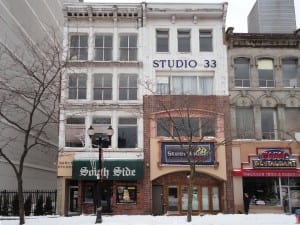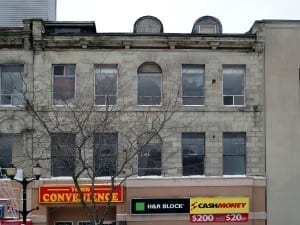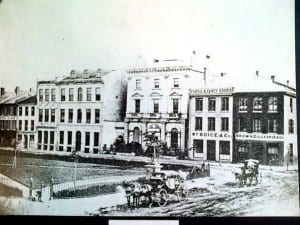Support the ACO (Architectural Conservancy of Ontario) as yet another major block of history is threatened: Text from ACO newsletter
The following text is from the newsletter of the Architectural Conservancy of Ontario.
Past President Lloyd Alter writes:
It’s deja vu all over again as another major block of historic buildings are threatened, this time in Hamilton. Just like in Brantford a few years ago, the buildings were not designated, so the developer is able to do a Christmas shuffle, applying for a demo permit while Council on a break, so of course, as Ryan Greal of Raise the Hammer notes, “the City has no recourse but to issue the demolition permits for January 9, 2013.” Funny how that works. Amazing how efficient the Buildings Department in Hamilton is, when it comes to demo permits.
Kieran Dickson, our Vice President, External Affairs and Government Relations, has written an article about the Gore Park Streetwall in Raise the Hammer, which we republish below.
This is the kind of issue that the ACO was born to fight for, in communities where the Municipalities refuse to designate without owners consent, where the Heritage Committees are ignored or worse, where the developers hold all the cards, where heritage is considered an impediment to progress. On this last day of the year I hope that you will hit the Donate online through Canada Helps Link Here and make a tax-deductible donation to the ACO to help us in these struggles.
Keep up to date
The Hamilton Branch of the ACO has just started its own Facebook page, while the ACO Facebook page is updated regularly. But really, you can’t beat twitter, follow it here.
A call to action to save the Gore Park Streetwall
The Gore has been the heart of civic and commercial life in Hamilton since the earliest days of the city – and it remains so today. Postcard images of Gore Park have been synonymous with Hamilton for over 150 years, and this landmark has been the predictable destination when Hamiltonians have come together as a people, in protest or to celebrate the end of wars.
The importance of Gore Park to Hamilton’s history and identity cannot be overstated. But what exactly is “the Gore”? The park itself does contain a grand fountain, our Cenotaph, and some of our most important statues, but it isn’t really that narrow little triangle of land that means so much.
What’s truly important is the civic square, defined by an intact streetwall that includes important heritage buildings – some of which are older than the park itself.
The current plan to demolish a substantial portion of the streetwall along the south side of the Gore is a major threat to the integrity of this most important civic space.
The buildings
The buildings that are the subject of the demolition permit are 18-28 King Street East. This stretch is essentially four buildings, now divided into five storefronts.
The limestone-faced buildings at the west end, beside the Bank of Nova Scotia, date from the 1840s and were designed by William Thomas, about whom more below. The stone façades are essentially intact above storefront level and each building has interesting arched windows and decorative stone elements.
The one building has very distinctive “eyebrow” dormers with inverted U-shaped windows facing the Gore; two of these remain intact today.
There aren’t many pre-Confederation stone commercial buildings still standing in Hamilton. These two on the Gore appear to be in good shape, apart from the obvious cosmetic issues at storefront level.
Specifically, there doesn’t appear to be cracking or out-of-plane alignment visible from the exterior.
The other two buildings are of later construction, but are still over 135 years old. These are four-storey Victorian storefronts.
As with their older neighbours, the façades of these buildings have been significantly modified at street level, but many upper-floor window details and the cornices have survived. The eastern building (28 King Street East) has distinctive full-height windows in each upper-level floor.
As with the older Thomas buildings, the two Victorians look structurally sound, with no obvious deformities in the exterior masonry.
The quality of all of these buildings is reflective of the company they kept a hundred years ago, with the Birks Building at one end of the block and grand stone banks filling out the streetwall.
William Thomas
William Thomas designed some of Canada’s most important buildings in the mid-19th century. He was the architect of St. Paul’s Church and Inglewood House in Hamilton, but nationally he’s probably better known for projects such as the Brock Monument in Queenston, St. Lawrence Hall in Toronto, and the Commercial Bank of the Midland District — now part of the Galleria at Brookfield (BCE) Place.
More important than ever
Downtown Hamilton is undergoing a major transformation. The historic commercial and mixed-use districts of our lower city are now attracting young professionals, and the repurposing and renovation of properties around James North, Locke South and Ottawa Street have made these the neighbourhoods of choice for many.
The Gore has great potential for joining these vibrant mixed-use neighbourhoods. Its central location is very attractive for those seeking complete neighbourhoods with opportunities to live, work and play without having to drive. Indeed, the Gore Park area might well become one of Hamilton’s most desirable urban addresses within the next decade.
But such rejuvenation will only happen if we leverage the Gore’s appealing built form – the heritage buildings, the pedestrian-friendly intact streetwall, and the mix of residential, office, and retail uses.
For these reasons, we can’t accept the demolition of this streetwall on the Gore. While the buildings are privately owned, this threat to our civic space gives rise to a public interest – a public interest which is recognized and protected by the Ontario Heritage Act.
The demolition plan also threatens the private interests of those who have worked for years to redevelop our downtown in a way which makes the most of Hamilton’s distinctive architecture and civic spaces.
Call to action
The demolition permit may be executed as of January 9, 2013. Under normal circumstances, Council would have an opportunity to act upon the Municipal Heritage Committee’s recommendation to designate (and thereby protect) the buildings. But because the demolition permit was obtained before the holiday break, demolition may occur before the next Council meeting.
Accordingly, at the municipal level we need to call upon Council to have a special meeting before January 9th to address the issue – and to designate the buildings at that time. The email addresses of all members of Council, including Mayor Bratina, are linked at Raise the Hammer.
But we can’t safely assume that Council will have a chance to meet before demolition begins. Therefore, we also need to call on Minister Michael Chan, whose portfolio includes heritage, to issue a stop work order and/or a notice of intention to designate under the Ontario Heritage Act.
This will provide an opportunity for both City Council and the Province to address the question of whether these buildings deserve protection. Minister Chan’s email address is mchan.mpp.co@liberal.ola.org
Please contact these elected officials and also your local MPP to express your concern and to seek immediate action – and please share your letters as responses to this article. In addition, please consider joining the Architectural Conservancy of Ontario, which is fighting to protect built heritage in Hamilton and across Ontario.
Join a walking tour of the Gore
Date: Sunday, January 06, 2013
Time: 1:00 pm
Sunday, January 6 at 1:00 pm please join the Hamilton Branch of the ACO for a guided walking tour of the unique architecture of The Gore. Learn about the significance of the buildings that surround Hamilton’s iconic park and the district’s importance in Hamilton’s history.
Meet at the Statue of Queen Victoria.
Tour is weather dependent. If there is a blizzard or cold alert it will not take place. Watch for updates on Facebook here.
Call for submissions: Architectural Conservancy of Ontario’s 80th Anniversary Book
To celebrate all the ACO has accomplished over the past 80 years we will be putting together a book that highlights 80 buildings we’ve helped to save.
The buildings can be ones that the ACO owns, ones we have partnered to save, helped to fundraise for, provided advocacy or grants for, or been involved with in any way. We want to tell the diverse ACO story from all across Ontario.
We will use the book and the sites to highlight Architectural Conservancy of Ontario success stories over the 2013 year.
A nomination form, including instructions, can be found on the ACO website. The deadline for submission is January 30, 2013. Completed forms, along with all requested documentation and photographs, should be sent by email to Kayla Jonas.
Call for submissions: Acorn
Our fall issue of ACORN was a great success and I thank all our writers and contributors for their stories of local heritage landscapes. I’d also like to thank the NextGen members who wrote some articles for this issue: Tatum Taylor, Lindsay Benjamin, Vanessa Hicks, Amy Calder and Hillary Vaillancourt. Our Editor Leanne Piper and co-editors Emma Jenkin and Kayla Jonas were very patient in collecting the articles over the summer months.
The theme of the next issue of ACORN for publication in the early spring will be ACO?s anniversary celebration by telling the story of ACO?s history, changes over time and its key figures.
We encourage you to explore names like Eric Arthur, Peter Stokes, Herb Stovel, early branches (the first branch was Hamilton-Niagara as I understand. Tell us how your branch got started, key figures in your area who helped out, good stories about the branch. If you have long-time members, ask them to tell their stories.
If you have a story to tell, and need a writer, let us know.
If you are a writer and would like a story, let us know.
Requirements:
Articles should be 500-1000 words in length, sent as a word document. Please also include 2-3 high quality photographs. Add photo captions and credits to the bottom of the article, and send the photographs as attachments, do not embed them in the word document. Also include a short biography (2-3 sentences) about the author.
Inquiries and articles can be submitted to Susan Ratcliffe.
DEADLINE is January 15, 2013
Pencil in the dates:
Addenda
I was very impressed with this reference to Kieran Dickson’s clutter-free lifestyle in the Hamilton Spectator: Meet Kieran Dickson, a man who lives clutter-free.
I’ve been sending emails as suggested in the text above.
The email addresses for the Mayor of Hamilton and Councillors can be readily located online. For each email, I try to vary the wording slightly. I’ve also written to MPP Michael Chan as a way of expressing support for the effort to preserve these buildings.
Here’s a typical email:
Subject: Please do what you can to preserve the Gore Park Streetwall
Dear Mayor Bob Bratina
I live in Toronto. I’ve been following with interest the story related to the Gore Park Streetwall in Hamilton:
I encourage you to do what you can to preserve these buildings.
Best,
Jaan Pill
Responses to emails
Please refer to this update from Councillor Jason Farr of the City of Hamilton.
Urban planning history in Hamilton
The discussion to date regarding the Gore wall has prompted my interest in learning more about the history of urban planning in Hamilton.
I anticipate that I will learn about a range of responses to deindustrialization in that city. Ken Greenberg’s overview of the “modern movement” in architecture will also be of relevance, based on what I’ve read about modernist urban planning in Hamilton in the 1960s.






Leave a Reply
Want to join the discussion?Feel free to contribute!